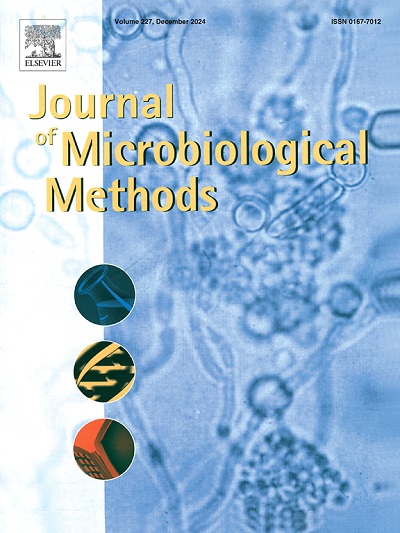Evaluation of nucleic acid extraction methods for recovery of Cyclospora cayetanensis, Salmonella enterica, and murine norovirus from water and sludge
IF 1.9
4区 生物学
Q4 BIOCHEMICAL RESEARCH METHODS
引用次数: 0
Abstract
The coccidian parasite Cyclospora cayetanensis is the causative agent for foodborne outbreaks of cyclosporiasis and multiple fresh produce recalls annually. In recent years, this organism has been reported in the water near produce growing operations during outbreak investigations, prompting a call for more research on its environmental prevalence in the United States. Currently, there is a lack of performance data available on methods for conducting this research, including the performance of DNA extraction methods for molecular testing. Extraction methods for environmental samples must be efficient due to the often-limited amount of target nucleic acid and the potential for molecular inhibitors present in an environmental sample. This study assessed the performance of C. cayetanensis nucleic acid extraction seeded into surface water, produce wash water, and tap water by two methods designed for use with environmental samples: the PowerViral and UNEX methods. The PowerSoil extraction method (2 g) was assessed for C. cayetanensis extraction from seeded sewage sludge – an environmental sample type used to evaluate parasite carriage within communities. Extraction performance of the PowerViral and UNEX methods were also assessed for the detection of the foodborne bacterial pathogen Salmonella and a surrogate for foodborne viruses, murine norovirus (MNV) seeded into surface water, produce wash water, and tap water. The PowerViral method resulted in consistent detection (83–100 %) of C. cayetanensis, S. enterica, and MNV across all water types. Detection rates for the UNEX method ranged from 56 to 100 % prevalence for tap water and wash water, but there were no detections for any microbe from surface water. The PowerSoil method resulted in poor recovery of C. cayetanensis from sludge (≤1 % recovery), while both the PowerViral and UNEX methods effectively recovered C. cayetanensis from sludge (4–36 % recovery).
从水和污泥中提取卡耶坦环孢子虫、肠沙门氏菌和鼠诺如病毒的核酸提取方法评价。
球虫寄生虫卡耶坦环孢子虫是食源性环孢子病暴发和每年多次新鲜农产品召回的病原体。近年来,据报道,在疫情调查期间,在农产品种植作业附近的水中发现了这种生物,这促使人们呼吁对其在美国的环境流行进行更多研究。目前,缺乏进行这项研究的方法的性能数据,包括用于分子检测的DNA提取方法的性能。环境样品的提取方法必须是有效的,因为目标核酸的量通常是有限的,并且环境样品中存在潜在的分子抑制剂。本研究采用PowerViral和UNEX两种环境样品提取方法,分别对地表水、生产洗涤水和自来水中卡叶紫荆核酸的提取性能进行了评价。采用PowerSoil提取法(2 g)对有籽污水污泥中C. cayetanensis的提取效果进行了评估,这是一种用于评估群落内寄生虫携带的环境样本类型。对PowerViral和UNEX方法的提取性能进行了评估,以检测食源性细菌病原体沙门氏菌和食源性病毒、鼠诺如病毒(MNV)的替代品,这些病毒投种到地表水、生产洗涤水和自来水中。PowerViral方法的检测结果一致(83-100 %),在所有的水类型中,卡耶坦弧菌、肠球菌和MNV的检测结果一致。UNEX方法在自来水和洗涤水中的检出率为56% ~ 100% %,但在地表水中未检出任何微生物。PowerSoil法对污泥中卡耶坦菌回收率较低(回收率≤1 %),而PowerViral法和UNEX法对污泥中卡耶坦菌回收率均较好(回收率4-36 %)。
本文章由计算机程序翻译,如有差异,请以英文原文为准。
求助全文
约1分钟内获得全文
求助全文
来源期刊

Journal of microbiological methods
生物-生化研究方法
CiteScore
4.30
自引率
4.50%
发文量
151
审稿时长
29 days
期刊介绍:
The Journal of Microbiological Methods publishes scholarly and original articles, notes and review articles. These articles must include novel and/or state-of-the-art methods, or significant improvements to existing methods. Novel and innovative applications of current methods that are validated and useful will also be published. JMM strives for scholarship, innovation and excellence. This demands scientific rigour, the best available methods and technologies, correctly replicated experiments/tests, the inclusion of proper controls, calibrations, and the correct statistical analysis. The presentation of the data must support the interpretation of the method/approach.
All aspects of microbiology are covered, except virology. These include agricultural microbiology, applied and environmental microbiology, bioassays, bioinformatics, biotechnology, biochemical microbiology, clinical microbiology, diagnostics, food monitoring and quality control microbiology, microbial genetics and genomics, geomicrobiology, microbiome methods regardless of habitat, high through-put sequencing methods and analysis, microbial pathogenesis and host responses, metabolomics, metagenomics, metaproteomics, microbial ecology and diversity, microbial physiology, microbial ultra-structure, microscopic and imaging methods, molecular microbiology, mycology, novel mathematical microbiology and modelling, parasitology, plant-microbe interactions, protein markers/profiles, proteomics, pyrosequencing, public health microbiology, radioisotopes applied to microbiology, robotics applied to microbiological methods,rumen microbiology, microbiological methods for space missions and extreme environments, sampling methods and samplers, soil and sediment microbiology, transcriptomics, veterinary microbiology, sero-diagnostics and typing/identification.
 求助内容:
求助内容: 应助结果提醒方式:
应助结果提醒方式:


